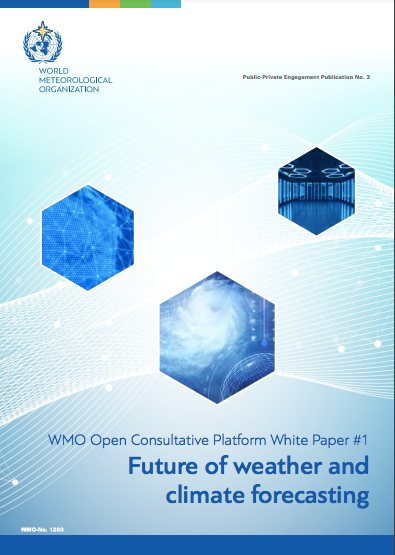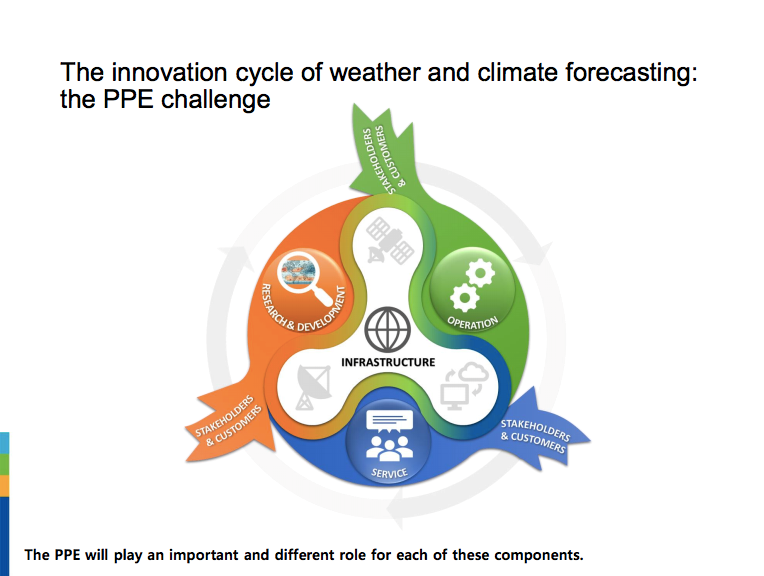The Future of Weather and Climate Services
WMO has held a top-level dialogue session on the future of weather and climate forecasting as part of its ongoing drive to strengthen collaboration and Public-Private Engagement (PPE) in order to support climate adaptation, sustainable development and build resilience.
- Опубликовано в партнерстве с:
- ACP Secretariat
- Public-Private Engagement
- Partnerships
- Weather
- Climate Services
- Meteorology
- NMHSs

WMO has held a top-level dialogue session on the future of weather and climate forecasting as part of its ongoing drive to strengthen collaboration and Public-Private Engagement (PPE) in order to support climate adaptation, sustainable development and build resilience.
The second high-level session of the Open Consultative Platform, held virtually on 26-27 May, focused on two priority grand challenges: the future of weather and climate forecasting; and the evolving roles and responsibilities – the future of the National Meteorological and Hydrological Services (NMHSs).
It was hosted by WMO Secretary-General, Prof. Petteri Taalas, and WMO President Prof. Gerhard Adrian, and brought together leaders from the NMHSs, private companies, meteorological equipment providers, the research community and academia.
The demand for weather and climate forecast information has grown rapidly during the last decade and will increase even faster in the coming years in view of growing extreme weather, climate, water and other environmental risks.
The generation and provision of these services has been revolutionized by supercomputers, satellite and remote sensing technology, smart mobile devices. A growing share in these innovations has come from the private sector. At the same time progress has been hampered by persisting holes in the basic observing system.
“Undoubtedly, the 2020s will bring significant changes to the weather, climate and water community: on the one hand through rapid advancement of science and technology, and on the other hand through a swiftly changing landscape of stakeholders with evolving capabilities and roles,” says WMO Secretary-General Prof. Petteri Taalas.
“Such changes will affect the way weather and climate forecasts are produced and used,” he says.

The Future of Weather Forecasting:
Dr. Gilbert Brunet, Chair of the WMO Scientific Advisory Panel (SAP) and Chief Scientist of the Bureau of Meteorology of Australia presented a new White Paper on Future of Weather and Climate Forecasting.
The White Paper traces the development of the weather enterprise and examines challenges and opportunities in the coming decade. It examines three overarching components of the innovation cycle: infrastructure, research and development, and operation.
These will facilitate a new generation of weather and climate services that help people, businesses and governments to better mitigate risks, reduce losses, and materialize opportunities from the new intelligence of highly accurate and reliable forecasts and predictions,” says the White Paper.
The main structures of the forecasting enterprise will not change significantly in the coming decade, but we will see notable shift in roles and performance requirements, said Dr. Brunet.
- International cooperation at State level will continue to be a main factor. WMO should increase significantly its effort in international R&D coordination and promotion.
- At the national level, NMHSs need to engage more in community-based modelling and data initiatives, and R&D consortia. The importance of working closely with users and the opportunities for PPE should be recognized and promoted.
- WMO should continue to be the backbone of capacity building and to provide numerical forecast for various global and regional service providers.
- Governments need to sustain and ideally accelerate public investments in global observing system and supercomputing capability which are fundamental for the PPE.
The development/improvement of climate models needs to be in line with the strategy for weather prediction. A unified single model system across a range of timescales (nowcasting to centennial) and spatial scales (convective scale to climate system Earth modelling) is possible and desirable in this context, said Dr. Brunet.
Dr. Florence Rabier, Director-General of the European Centre for Medium Range Weather Forecasts, highlighted the huge potential for Earth System modelling
These will require major technological developments in high-performance computing, Cloud technology and artificial intelligence and machine learning, as well as more observations from satellites, private companies
For a step-change in such developments, enhanced partnerships are needed between Member States, WMO, academia and industry, said Dr Rabier.
Dr. Kevin Petty, Director of Science and Forecast Operations and PPP, The Weather Company, IBM, discussed the Global high-Resolution Atmospheric Forecast (GRAF) System: Advancing Numerical Weather Prediction through strategic partnerships.
Strategic partnerships are an effective and efficient way of achieving goals and objectives, particularly on compressed timescales and can potentially open the door to other collaborative opportunities. They should be built around a common goal, even if the motivation of each partner may be slightly different. Engaging the right partners is essential in any endeavor; efforts should not be made to force fit, he said.
Evolving Roles and Responsibilities – Future of National Meteorological and Hydrological Services

While National Meteorological and Hydrological Services in all 193 WMO Members are still the public entities designated by governments to provide meteorological and related services, many other providers have entered the weather forecasting business in recent decades, including intergovernmental organizations like ECMWF, private sector companies and academic institutions.
- The 2021-2030 decade: Significant changes envisaged in the roles and operations of all stakeholders in the weather and climate enterprise including the NMHSs
- The question of the NMHS’s roles and responsibilities is a central question we should be discussing continuously
- NMHSs need to become more society oriented
- The great diversity in the legal and institutional frameworks under which the NMHSs are set and operate in the different countries will remain, there will be no “one size fits all”
- A common challenge for the NMHS will be how to engage with other stakeholders in a multi-sector enterprise that will serve better the society and will better use available resources
- The forthcoming OCP White Paper “Future of National Meteorological and Hydrological Services” will try to address these issues and provide guiding scenarios for mid- to long-term planning by decision-makers
Ms. Marianne Thyrring, Permanent Representative of Denmark with WMO, highlighted the need for a shift in DMI’s focus from product-oriented to society-oriented and its role to be a data pusher by making DMI data open and free for everybody to use.
Prof. Mansur Bako Matazu, Permanent Representative of Nigeria with WMO, shared the experiences of the Nigerian Meteorological Agency, NiMet, with public-private partnerships for weather and climate services.
NMHSs cannot continue to depend on themselves alone, he said, given that government funding for provision of meteorological infrastructure not sustainable. The weather enterprise is today a global public-private partnership which can help meet infrastructure deficiencies. If properly backed by legal and other frameworks, weather enterprise can bring substantial revenue streams to NMHSs, he said,
Naoyuki Hasegawa, Permanent Representative of Japan with WMO, with his colleague, Masanori Obayashi, explained how the Meteorological Service Act gives JMA responsibility, not only for its operations, but for the whole system nationwide. JMA facilitates further use of meteorological data and services in economic and social activities, through initiatives such as Weather Business Consortium, while working to improve its own public services in collaboration with private and academic sectors. For versatile response to rapidly changing social environments and scientific technologies, it is of vital importance to promote engagement of stakeholders through continuous dialogues and mutual understanding, he said.
The Open Consultative Platform was launched in 2019 as a result of the landmark “Geneva Declaration: Building Community for Weather, Climate and Water Actions” which was approved by the World Meteorological Congress in 2019.
The Geneva Declaration – 2019 underlines the “need to strengthen the entire weather, climate and water services value chain – from acquisition and exchange of observations and information, through to data processing and forecasting, and service delivery – to meet growing societal needs”, and points to the “evolving capabilities and growing engagement of the private sector in contributing to all links of the value chain and accelerating innovation”.
За дополнительной информацией, пожалуйста, обращайтесь:
- Clare Nullis WMO media officer cnullis@wmo.int +41 79 709 13 97
- Tatsuya Kimura Director, Public-Private Engagement Office tkimura@wmo.int

